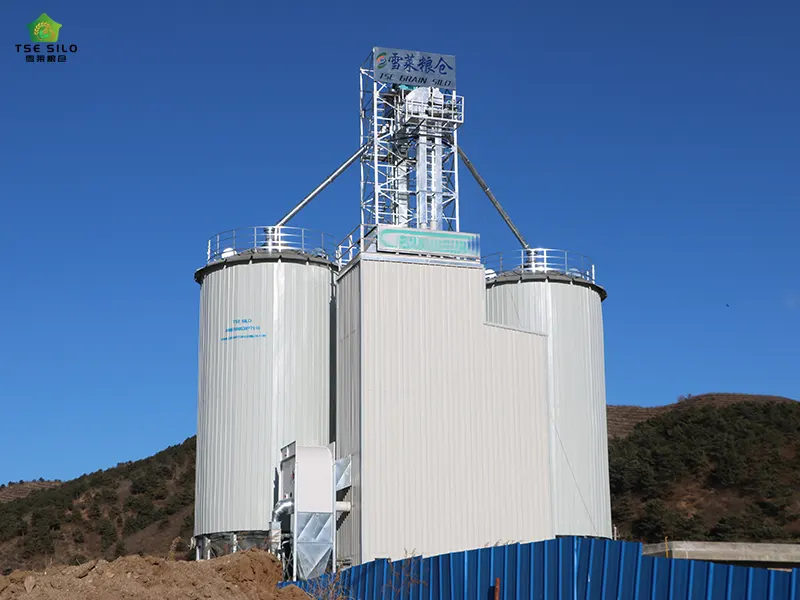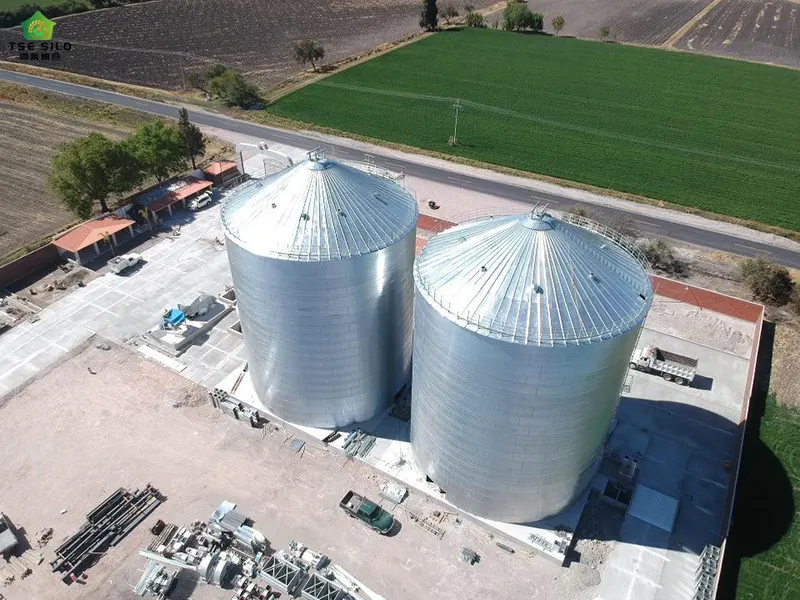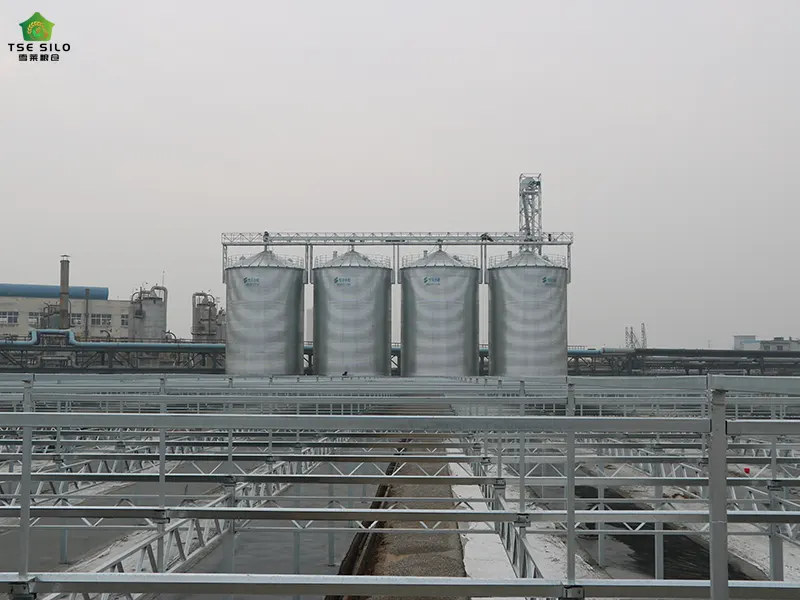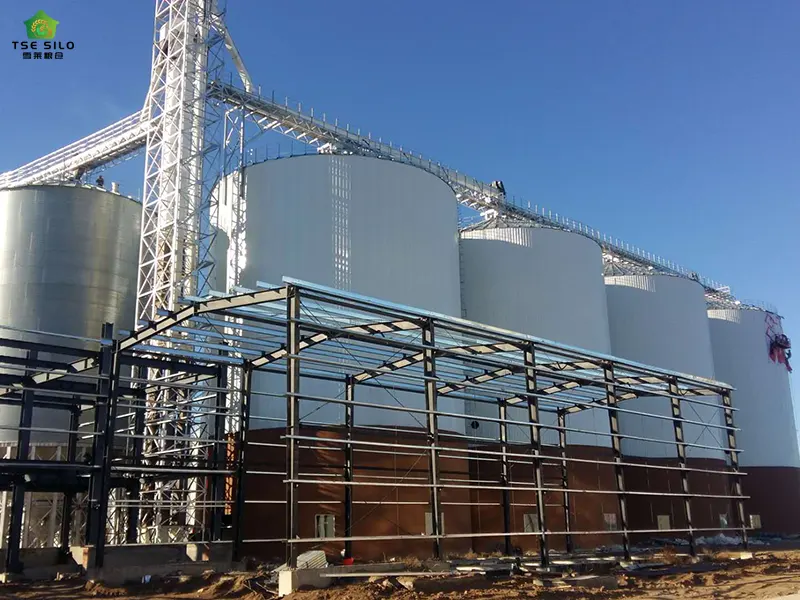


In the modern grain storage industry, large grain silos have become one of the necessary infrastructures for large farms. With the continuous development of science and technology, the supporting facilities of large grain steel silos are also being gradually improved. Among the many supporting facilities, the drying system is a relatively large and practical module. It is mainly a system or equipment that combines grain drying function with steel silo storage function. It uses steel silos as drying containers or is closely integrated with drying equipment to achieve the purpose of moisture regulation and storage of grain entering the warehouse (such as corn, wheat, rice, soybeans, etc.). Grain steel silos equipped with drying systems have greatly improved both grain storage efficiency and grain safety.
The following are the main components, working principles, types, advantages and disadvantages and applications of grain steel silo drying systems:
As a container for drying operations and the final storage silo. It mainly plays the role of storing grain.
Usually 275g spiral hemming fully galvanized steel plate assembled steel silos are used, which have good air tightness and corrosion resistance.
The bottom is usually designed in a cone shape to facilitate grain unloading. Ventilation holes or air distributors are provided at the bottom of the cone or on the wall of the silo.
Function: Generate hot air (heat medium) required for drying.
Type: Coal-fired boiler, oil/gas hot air furnace, biomass hot air furnace, electric heater, steam heat exchanger, solar assisted, etc. The choice depends on fuel availability, cost, environmental protection requirements and drying volume.
Function: Force hot air (or normal temperature air) into the grain pile and exhaust wet air.
Main equipment: High-pressure centrifugal fan (provides sufficient wind pressure to penetrate the grain layer), air supply duct, air distribution system (located at the bottom or wall of the silo to ensure that the hot air is evenly distributed through the grain layer), moisture outlet (located at the top or upper part of the silo to discharge hot and humid exhaust gas).
Key points: Air volume, air pressure, and air duct design are crucial to drying uniformity and efficiency.
Function: Monitor and control drying process parameters to ensure safety, efficiency and grain quality.
Monitoring parameters: Hot air temperature (inlet and return air), grain temperature (multiple points), ambient temperature and humidity, grain moisture (online or offline monitoring), fan status, heat source status, etc.
Control function: Automatically adjust hot air temperature (to prevent excessive damage to grain), control fan start and stop, set drying program (such as variable temperature drying), over-temperature alarm, fault diagnosis, etc. Modern systems mostly use PLC or microprocessor control, which can realize remote monitoring.
Cleaning equipment: Remove impurities before entering the warehouse.
Lifting and conveying equipment: Deliver grain to the drying warehouse or transfer between different warehouses.
Moisture detector: Used for moisture measurement before, during and after drying.
Dust removal system: Treat dust in exhaust gas from the exhaust outlet to meet environmental protection requirements.


1. Grain loading: Wet grain is loaded into the steel silo through the conveying equipment to reach the predetermined height.
2. Air supply: The dry hot air generated by the hot air furnace is forced to pass through the grain layer from bottom to top (or according to the designed direction) by the high-pressure fan through the air distribution system at the bottom of the silo (or a specific air duct).
3. Heat and mass exchange: The hot air contacts the wet grain, transfers heat to the grain particles, and takes away the moisture evaporated from the grain.
4. Dehumidification: The humid and hot exhaust gas that absorbs moisture is discharged from the dehumidification port on the top of the silo.
5. Circulation and monitoring: Hot air is continuously supplied and moisture is continuously discharged. The control system monitors key parameters (such as hot air temperature, grain temperature, and moisture changes) in real time, and adjusts the hot air temperature according to the set program or algorithm to prevent grain from overheating and deterioration (such as cracking and burning), while optimizing the drying efficiency.
6. Slow drying (optional): During or after the drying process, heating may be stopped, and only ventilation or standing for a period of time may be performed to allow the moisture inside the grain to diffuse to the surface layer for equilibrium, which is beneficial to improving the uniformity and quality of drying and reducing energy consumption.
7. Cooling (optional): After the target moisture is reached during drying, room temperature air may be introduced to cool the grain for safe storage or unloading.
8. Storage or unloading: The dried and cooled grain can be directly stored in the silo or unloaded through the silo bottom unloading port.
The most common method. The grain is stationary in the silo.
Hot air penetrates the entire grain pile for drying.
Advantages: The structure is relatively simple, the operation is intuitive, and the investment cost is relatively low (especially for the transformation of existing steel silos).
Disadvantages: The drying speed is slow (especially in deep grain layers), batch operation, and the drying uniformity is greatly affected by the thickness of the grain layer and the uniformity of air distribution. Suitable for small and medium-sized grain depots or farms.
Grain moves slowly downward during drying (e.g., flow rate is controlled by a bottom unloading device).
Hot air usually flows in counterflow or crossflow through the moving grain layer.
Advantages: Continuous operation, high efficiency, large single-bin processing capacity, relatively good drying uniformity.
Disadvantages: The system is more complex (precise control of grain flow rate and hot air is required), and the investment cost is high. Often used in conjunction with multiple steel silos (e.g., wet grain silo -> drying silo -> dry grain storage silo). Suitable for large grain depots or processing enterprises.
Grain at the bottom of the silo is continuously extracted using lifting equipment, quickly dried by an external dryer (e.g., tower dryer), and then returned from the top of the silo. The grain in the silo is circulated and dried.
Advantages: Fast drying speed, high efficiency, relatively small damage to grain quality (quick drying), and not limited by the thickness of the grain layer in the silo.
Disadvantages: The system is complex (additional dryers and circulation equipment are required), and the equipment investment and energy consumption are relatively high. It is suitable for occasions with high requirements for drying speed and quality.
Integration: Drying and storage are integrated, which saves separate drying equipment and space, reduces the number of grain handling times, and reduces the breakage rate and loss.
Saving investment: For existing steel silos, the drying function can be modified, which is cheaper than building a new independent drying line.
Storage safety: After drying, the grain can be safely stored directly in the silo (moisture control is the key to safe storage).
Environmental protection: Closed system, dust and exhaust gas are easy to centrally handle (dust removal system is required).
Flexibility: Batch system can dry different batches of grain as needed.
Automation: Modern control systems can achieve high automation, reducing manual intervention and operating risks.


Drying speed: The fixed bed drying speed is relatively slow, especially in deep grain layers (large wind resistance).
Uniformity: Ensuring uniformity of drying in large grain piles (especially the center and edge, upper and lower layers) is a technical difficulty, which depends on excellent air distribution system design and control strategy.
Energy consumption: Drying itself is a high-energy operation, and it is necessary to optimize the heat source efficiency and drying process to reduce costs.
Initial investment: High-quality drying systems (especially continuous or circulating types) and their supporting equipment require a large investment.
Technical requirements: Professional design, installation, operation and maintenance personnel are required.
Grain layer restrictions: Fixed bed drying has restrictions on the height of the grain layer. Too high will lead to excessive wind resistance, low efficiency or even ineffective drying.
Potential damage: Improper control (such as too high temperature, too fast drying) may lead to a decrease in grain quality (increased cracking rate, reduced germination rate, nutritional loss, etc.).
Farms/cooperatives: Process self-produced grain to meet storage or sales requirements.
Grain storage warehouse: Purchase large quantities of wet grain and store it safely after drying.
Grain processing enterprises: Provide qualified moisture raw materials for the processing link.
Seed companies: Dry seed grains safely to ensure germination rate.
Port grain depots: Handle imported and exported grains.
Grain steel silos drying system is an important facility to achieve post-harvest grain loss reduction, ensure storage safety, and improve grain quality. It combines the storage advantages and drying process of steel silos, and is particularly suitable for direct drying operations at storage points. Selecting the appropriate system type (fixed bed, continuous, circulation) and configuration (heat source, fan, control), and ensuring good design and operation management, is the key to fully exerting its effectiveness, reducing costs and ensuring grain quality. With the development of technology, more efficient, intelligent, energy-saving and environmentally friendly drying control systems are the future development trend.
Written by
Shandong Shelley Grain Steel Silo Co., Ltd
Editor Jin
www.grainstoragesilos.com
WhatsApp : +86-18653877118
Email : shelley@cnshelley.com